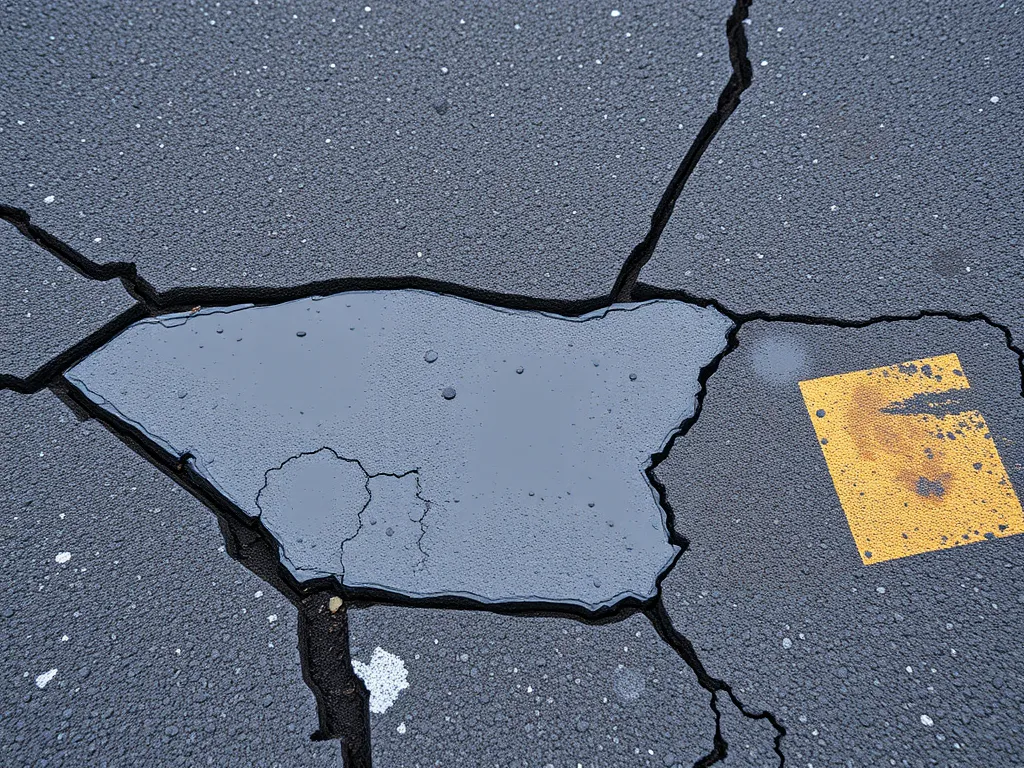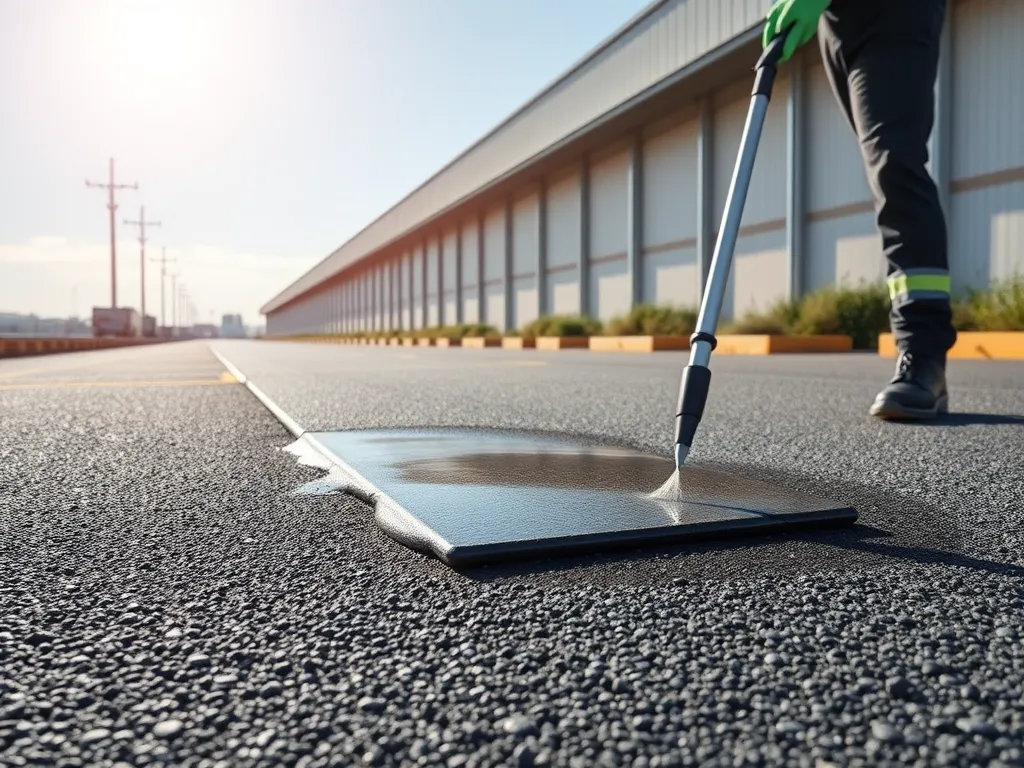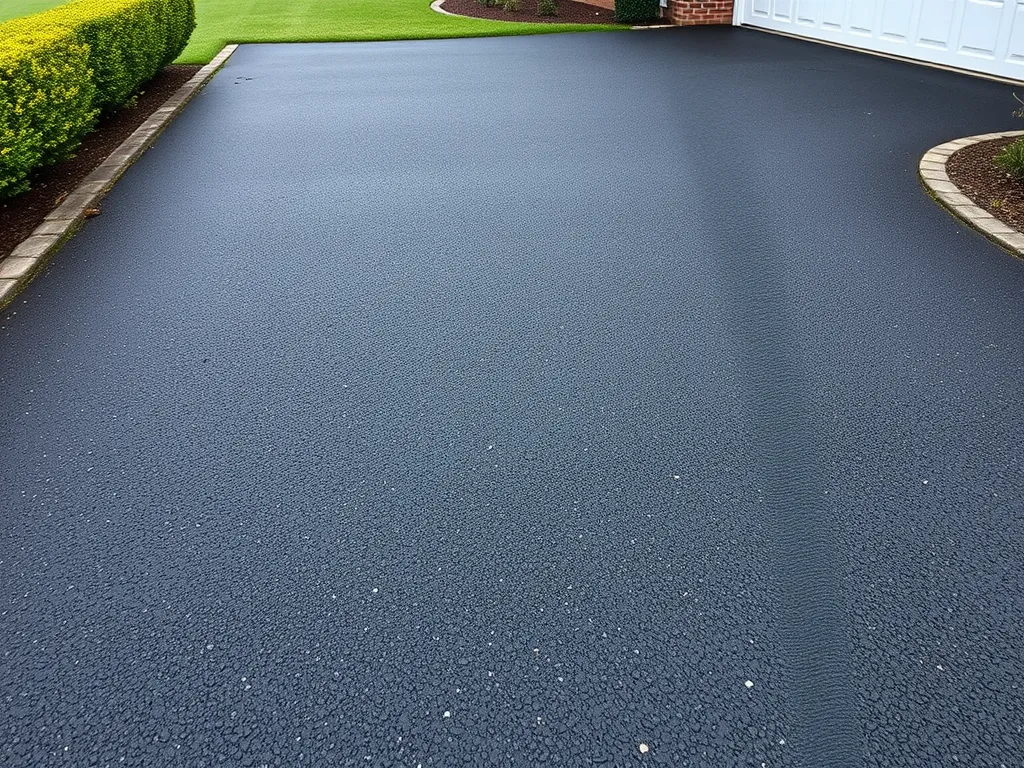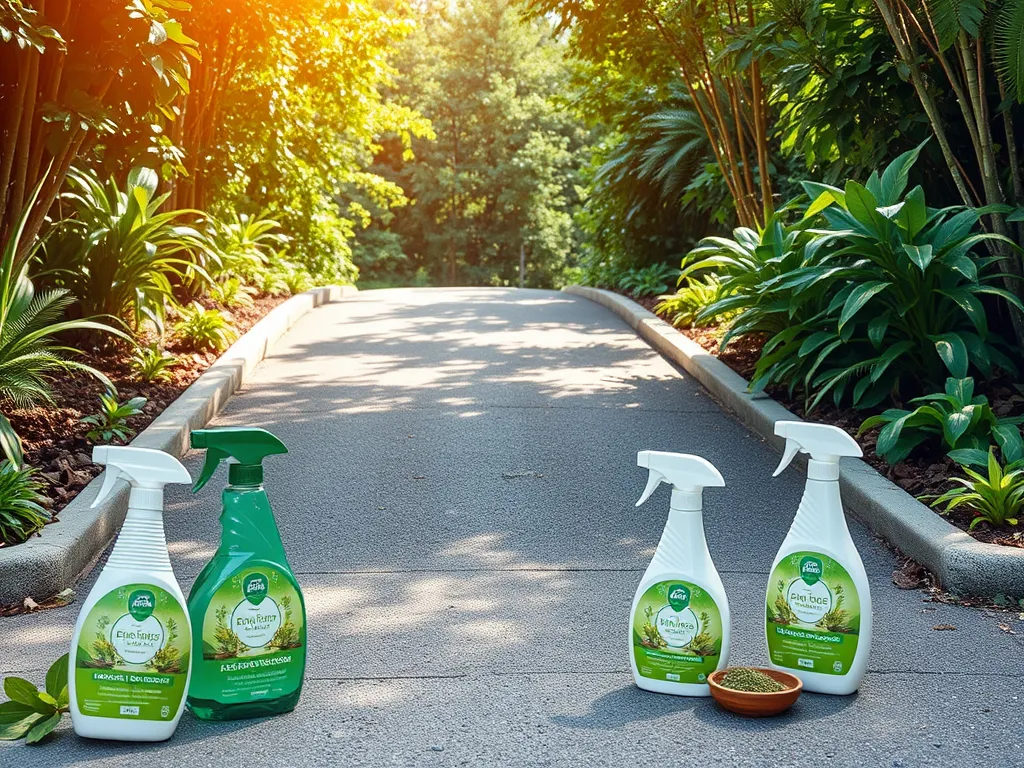Can You Pressure Wash Asphalt? The Safe Cleaning Guide You Need
Published on: October 4, 2025 | Last Updated: April 14, 2025
Written By: George Voss
Yes, you can pressure wash asphalt driveways and surfaces when using proper techniques. Keep pressure below 2000 PSI and use a fan tip nozzle to prevent surface damage. High-pressure streams can erode the asphalt binder (bitumen) or dislodge aggregates, leading to cracks and potholes. Effective cleaning requires balancing power with surface protection—target oil stains with eco-friendly detergents and avoid narrow spray patterns.
This guide covers pressure washer settings for asphalt, step-by-step cleaning methods, and solutions for tough stains. Learn how to choose equipment (like 1200-2000 PSI models), apply sealcoating after washing, and explore alternatives like soft washing. Get maintenance tips to extend your driveway’s lifespan while protecting local waterways from runoff contaminants.
Contents
- Introduction to Pressure Washing Asphalt
- Understanding Asphalt Composition and Vulnerabilities
- Pressure Washing Basics for Asphalt
- Step-by-step Guide to Pressure Washing Asphalt Safely
- Addressing Oil Stains on Asphalt With Pressure Washing
- Alternatives to Pressure Washing Asphalt
- Maintenance Tips to Protect Your Asphalt Driveway
- Environmental Care When Washing Asphalt
- FAQs About Pressure Washing Asphalt
- Closing Thoughts
- Additional Resources for You:
Introduction to Pressure Washing Asphalt
Yes, you can pressure wash asphalt surfaces when done correctly. High-pressure water jets effectively remove dirt, oil stains, and debris from driveways or parking lots. But success hinges on technique, equipment settings, and surface condition. Done right, this method restores faded blacktop without harming its structural integrity.
Modern pressure washers operate between 500-4000 PSI. Asphalt requires 1200-1900 PSI for safe cleaning. Exceeding this range risks surface erosion or binder damage. Use a 25-degree fan nozzle to distribute force evenly. Avoid concentrated streams that gouge the asphalt matrix.
Why Pressure Washing Works for Asphalt
- Removes embedded grease and tire marks
- Clears moss and algae from shaded areas
- Restores color by lifting oxidized particles
Key Limitations to Note
- Avoid washing new asphalt (under 6-12 months old)
- Skip high-pressure jets on cracked or weathered surfaces
- Never use hot water above 140°F – it softens bitumen
Pressure washing an asphalt driveway extends its lifespan by preventing water seepage into cracks. Regular cleaning also reduces freeze-thaw damage in colder climates. But improper use strips protective sealcoats or dislodges aggregates, leading to pitting.
Next, let’s explore how asphalt’s unique composition impacts pressure washing outcomes. Knowing the material’s strengths and weaknesses ensures your cleaning routine boosts durability instead of cutting it short.
Understanding Asphalt Composition and Vulnerabilities
Asphalt mixes crushed stone, sand, and gravel (95%) with a sticky petroleum binder called bitumen (5%). This combination creates a flexible surface that withstands traffic but remains porous. These traits dictate how it reacts to high-pressure cleaning methods like power washing.
Why Asphalt’s Structure Matters for Pressure Washing
Bitumen softens under heat and hardens when cool. During summer, asphalt becomes more pliable, making aggressive scrubbing or PSI above 3,000 risky. The material’s porous nature also traps debris, requiring careful cleaning to avoid dislodging aggregates. Pressure washing asphalt driveways at incorrect angles or pressures can strip the top layer, exposing weaker layers to wear and weather.
Common Risks Of Improper Asphalt Cleaning
Excessive force during power washing asphalt blacktop causes three primary issues:
| Risk | Impact | Repair Cost |
|---|---|---|
| Surface Erosion | Loss of aggregates, creating rough patches | $1.50–$3.00/sq.ft. |
| Pothole Formation | Water seeps into base layers, destabilizing pavement | $50–$300 per hole |
| Sealcoat Damage | Premature wear requiring resealing | $0.15–$0.25/sq.ft. |
National averages. Costs vary by region and damage severity.
Chemicals like gasoline or bleach worsen these effects by degrading bitumen bonds. Even biodegradable cleaners need proper dilution to prevent surface breakdown.
With these vulnerabilities in mind, let’s examine how to balance effective cleaning with asphalt preservation.

Pressure Washing Basics for Asphalt
Pressure washing asphalt needs care. The right tools and methods keep your drive clean without harm. Let’s break down key facts.
Is It Safe to Pressure Wash Asphalt Driveways?
Yes, you can pressure wash asphalt driveways if done right. Use a PSI under 1,500. Keep the nozzle 12+ inches from the surface. New asphalt (under 1 year old) is softer—wait 6-12 months before washing. High pressure strips the top layer, leaving pits or grooves. Stick to wide spray tips (25-40 degree) for even clean.
Benefits Of Pressure Washing Asphalt Surfaces
Done well, pressure washing:
- Removes oil, dirt, moss, and mildew
- Stops cracks by clearing grit from joints
- Boosts curb appeal fast (cleans 500 sq. ft. in 30 mins)
Clean driveways last 25% longer. It costs 30% less than manual scrubbing for large areas.
Potential Damage From Incorrect Pressure Washing
Wrong methods cause:
- Surface erosion (visible in 1-2 years)
- Water seeping into base layers ($3-$5/sq. ft. to fix)
- Faded spots from harsh detergents
PSI over 2,000 can tear asphalt binders. Avoid narrow spray patterns—they cut like blades.
Ready to learn the step-by-step? Let’s cover gear picks, safe PSI ranges, and pro tips to shield your drive.
Also See: Cold Mix Asphalt and Road Safety: A Smart Solution
Step-by-step Guide to Pressure Washing Asphalt Safely
Pressure washing asphalt requires precision to avoid surface damage. Follow these steps to clean driveways effectively while preserving structural integrity.
Choosing the Right PSI for Asphalt (Ideal Range)
Use a pressure washer with 1,200-1,900 PSI for asphalt surfaces. Higher PSI risks eroding the top layer of aggregates and binder. Gas-powered units often exceed safe limits—opt for electric models with adjustable settings. Pair with a 25° nozzle to disperse force evenly. For older or cracked blacktop, stay below 1,500 PSI to prevent further deterioration.
Essential Equipment and Preparation Steps
Gather a surface cleaner attachment, stiff broom, biodegradable detergent, and protective gear. Clear debris with the broom, then pre-treat oil stains with a degreaser. Check for cracks wider than 1/4 inch—fill them before washing to avoid water infiltration. Block nearby plants with plastic sheeting to shield them from runoff.
Proper Technique for Washing Asphalt Driveways
Start at the driveway’s highest point, moving the wand in steady, overlapping strokes. Keep the nozzle 3-4 feet from the surface, angling spray at 45° to avoid lifting aggregates. For large areas, attach a surface cleaner to maintain consistent pressure and speed. Rinse detergent within 10 minutes to prevent residue buildup.
Post-washing Care for Longevity
Allow 24-48 hours for the asphalt to dry completely. Apply a coal-tar or asphalt-based sealant at 55°F or warmer to restore protection. Address any new cracks with rubberized filler. Schedule sealcoating every 2-3 years, costing $0.15-$0.25 per square foot, to extend pavement life by up to 10 years.
Stubborn oil and grease stains demand specialized approaches—let’s explore targeted methods next.

Addressing Oil Stains on Asphalt With Pressure Washing
Oil stains pose a tough challenge for asphalt surfaces. While pressure washing works well for general cleaning, greasy marks need targeted strategies to prevent permanent discoloration or surface degradation.
Pre-treatment Methods for Oil and Grease Removal
Start by blotting fresh spills with kitty litter or sawdust within 15 minutes—these absorbents soak up 80-90% of oil before it seeps deeper. For set-in stains, apply a degreaser containing trisodium phosphate (TSP) or citrus-based solvents. Let the solution dwell for 10-15 minutes to break down grease bonds. Avoid wire brushes; use stiff nylon bristles to scrub without scratching the asphalt surface.
| Method | Effectiveness | Dwell Time |
|---|---|---|
| Kitty Litter | Absorbs surface oil | 15-30 mins |
| TSP Degreaser | Penetrates deep stains | 10-15 mins |
| Baking Soda Paste | Lifts light residue | 20-30 mins |
Using Detergents Safely With Pressure Washers
Pair pressure washers set to 1,200-1,500 PSI with asphalt-safe detergents. Look for pH-neutral formulas labeled for use on bitumen surfaces. Apply cleaner at a 3:1 water-to-detergent ratio using the washer’s low-pressure nozzle. Keep the wand 18-24 inches from the surface to avoid stripping the top layer. Rinse thoroughly—leftover soap residue attracts dirt, speeding up re-staining.
Never use bleach, ammonia, or gasoline-based cleaners. These solvents break down asphalt binders, causing raveling or cracks within weeks. For eco-friendly options, try oxygenated bleach solutions diluted to ½ cup per gallon of water.
While pressure washing tackles most stains, some scenarios demand gentler methods to preserve your driveway’s integrity.
Alternatives to Pressure Washing Asphalt
While pressure washing works for many asphalt surfaces, some scenarios demand gentler or specialized approaches. Explore these effective methods for cleaning blacktop without risking surface damage.
Soft Washing for Delicate Asphalt Areas
Soft washing uses low-pressure streams (500-800 PSI) paired with biodegradable detergents to lift stains. This method prevents aggregate displacement in aged asphalt or recently sealed driveways. Specialized surfactants break down mildew, algae, and embedded dirt without eroding the bitumen binder. Contractors frequently use this for driveways over 10 years old showing surface raveling or cracking.
| Scenario | Recommended PSI | Cleaning Agent |
|---|---|---|
| New asphalt (0-2 years) | 600-800 | pH-neutral cleaner |
| Aged asphalt with cracks | 500-700 | Oxygen bleach solution |
| Oil-stained blacktop | 700-1000 | Degreaser + citrus solvent |
Manual Cleaning Methods for Blacktop Driveways
Stiff-bristle brooms and asphalt-safe cleaners remove surface debris without water pressure. For grease spots, apply powdered pumice or cornstarch to absorb residues before scrubbing. This approach works well for routine maintenance, cutting cleaning costs by up to 40% compared to machine methods. Use push brooms with synthetic fibers—natural bristles can leave organic matter that promotes weed growth.
Eco-friendly Solutions for Asphalt Maintenance
Biodegradable cleaners like Simple Green or BioClean reduce chemical runoff into storm drains. Cold-water washing paired with enzymatic treatments breaks down oil deposits over 24-48 hours, preserving asphalt integrity. Some municipalities mandate these methods; check local codes before cleaning. For moss removal, vinegar-water sprays (1:3 ratio) prove safer than metal scrapers that might gouge the surface.
Choosing the right method depends on your driveway’s age, stain type, and local regulations. Up next: strategies to extend your asphalt’s lifespan through proactive care.

Maintenance Tips to Protect Your Asphalt Driveway
Keep your asphalt strong with smart care steps. Focus on cleaning habits and safe products to stop cracks, stains, and wear.
Routine Cleaning Schedules for Asphalt Longevity
Clean blacktop twice a year with light pressure washing. Spring clears salt and grit. Fall removes leaves and mud. Spot-clean spills within 48 hours to stop oil from seeping into pores. Use a 1,300-1,600 PSI washer angled at 45 degrees to lift dirt without stripping binder. Blast debris from cracks to halt water damage.
Chemicals to Avoid When Cleaning Asphalt
Skip oil-based cleaners, acid washes (like muriatic), and strong solvents. These eat into bitumen, the glue that holds asphalt. Gasoline or paint thinners soften the surface, causing dips. Chlorine bleach fades the dark finish. Pick pH-neutral soaps made for asphalt. For oil spots, try dish soap with hot water before pressure washing.
Smart cleaning keeps driveways looking sharp for 15-20 years. Next, let’s tackle how to handle runoff and eco-safe methods.
Environmental Care When Washing Asphalt
Cleaning asphalt needs care for both the ground and nearby nature. Let’s break down key steps to keep things green.
Handling Runoff and Pollutants
When you wash asphalt, runoff can carry oil, grease, and soap into storm drains. These drains often link to rivers or lakes. Oil from cars or harsh cleaners harm fish and plants. Use a capture mat or gravel filter to trap grime before it spreads. Check local rules—some areas ban soap runoff under the EPA Clean Water Act.
Eco Cleaners for Safe Washing
Pick plant-based cleaners like Simple Green or BioClean. These break down fast without hurting soil or water. Skip products with phosphates or petroleum—they strip asphalt’s binder over time. Eco options work at 1:10 mixes (1 part soap to 10 parts water) and cost $0.15-$0.30 per square foot. They’re mild on seals and keep blacktop dark for 2-3 years longer.
Smart washing keeps your driveway clean and protects the land around it. Next, let’s explore how regular upkeep stops wear before it starts.

FAQs About Pressure Washing Asphalt
Is Pressure Washing Asphalt Driveways Common?
Yes, pressure washing is a popular method for cleaning asphalt driveways. Homeowners often choose this method to enhance curb appeal and maintain the surface’s integrity. When done correctly, it effectively removes dirt, oil, and grime without damaging the asphalt.
Can You Use Hot Water for Pressure Washing Asphalt?
It is not recommended to use hot water above 140°F for pressure washing asphalt. Hot water can soften the bitumen binder in asphalt, potentially leading to surface damage. Using cold water ensures the structural integrity of the asphalt during cleaning.
How Often Should You Pressure Wash Asphalt?
It is advisable to pressure wash asphalt driveways approximately twice a year. Regular cleaning helps maintain the driveway’s appearance and prevents the accumulation of dirt and contaminants that could lead to damage over time.
What Should You Do if Asphalt Begins to Crack After Pressure Washing?
If you notice cracks forming after pressure washing, address them promptly. Fill any visible cracks with a rubberized filler suitable for asphalt. Additionally, consider applying a sealant to protect the surface and prevent further deterioration.
Do You Need to Reseal Asphalt After Pressure Washing?
Yes, it is highly recommended to apply a sealant after pressure washing asphalt. Sealcoating helps protect the surface from UV rays, oil spills, and weather damage, extending the life of your driveway.
Can You Hire Professionals for Pressure Washing Asphalt?
Absolutely! Hiring professionals can be a great option, especially if you are unsure about doing it yourself. Professionals have the right equipment and expertise to safely pressure wash your asphalt surfaces without causing damage.
Closing Thoughts
Pressure washing asphalt can be an effective way to maintain its appearance and integrity, but it requires careful consideration. Understanding the vulnerabilities of asphalt is key. Proper technique, the right equipment, and mindful product use are essential for achieving optimal results without damaging the surface.
Remember to choose the appropriate PSI range and post-washing care to extend the life of your driveway. For those looking for alternatives, soft washing or manual cleaning methods can offer safer solutions. Always prioritize environmentally friendly practices to protect both your drive and the planet.
For more tips and resources on asphalt maintenance, check out Asphalt Calculator USA. Your asphalt deserves the best care!
Additional Resources for You:
- Kett, I. (1999). Asphalt Materials and Mix Design Manual. Oxford: Elsevier Science.
- Can you pressure wash asphalt? – Quora
- Asphalt/blacktop driveway – Pressure Washing Resource
- asphalt cleaning question ? – Residential Pressure Washing – Pressure Washing and Contractor Cleaning Forums – The Grime Scene
- Can You Pressure Wash Asphalt? How to Pressure Wash Asphalt


